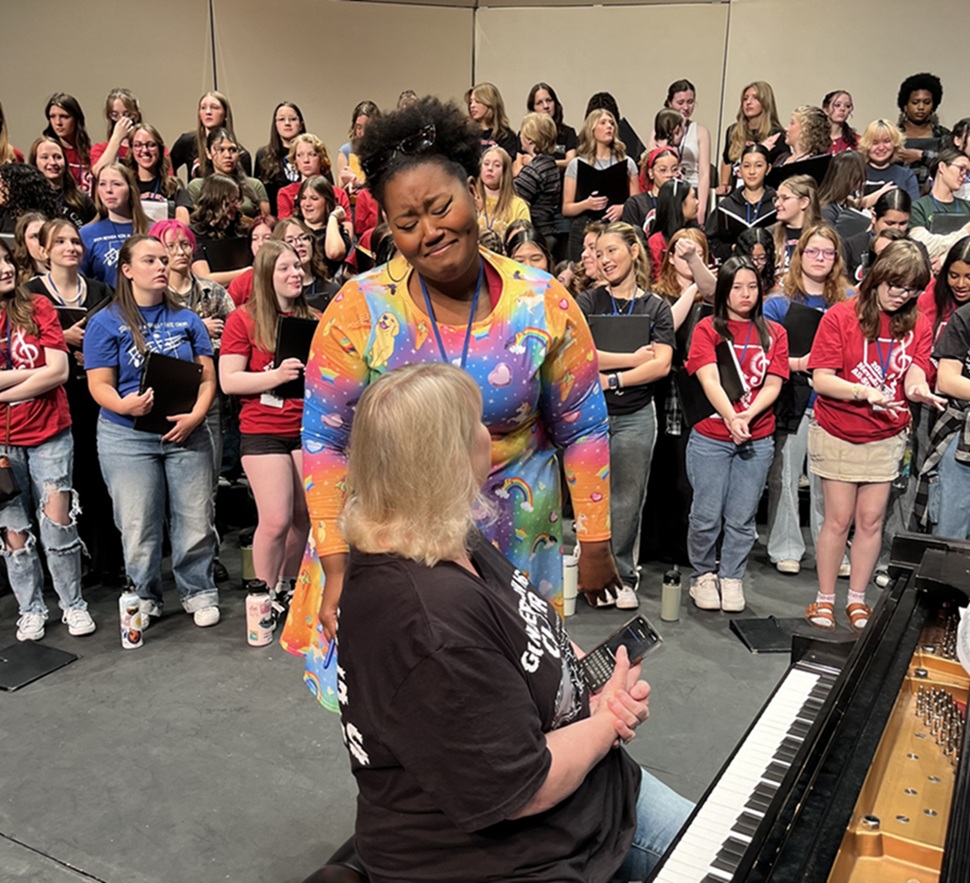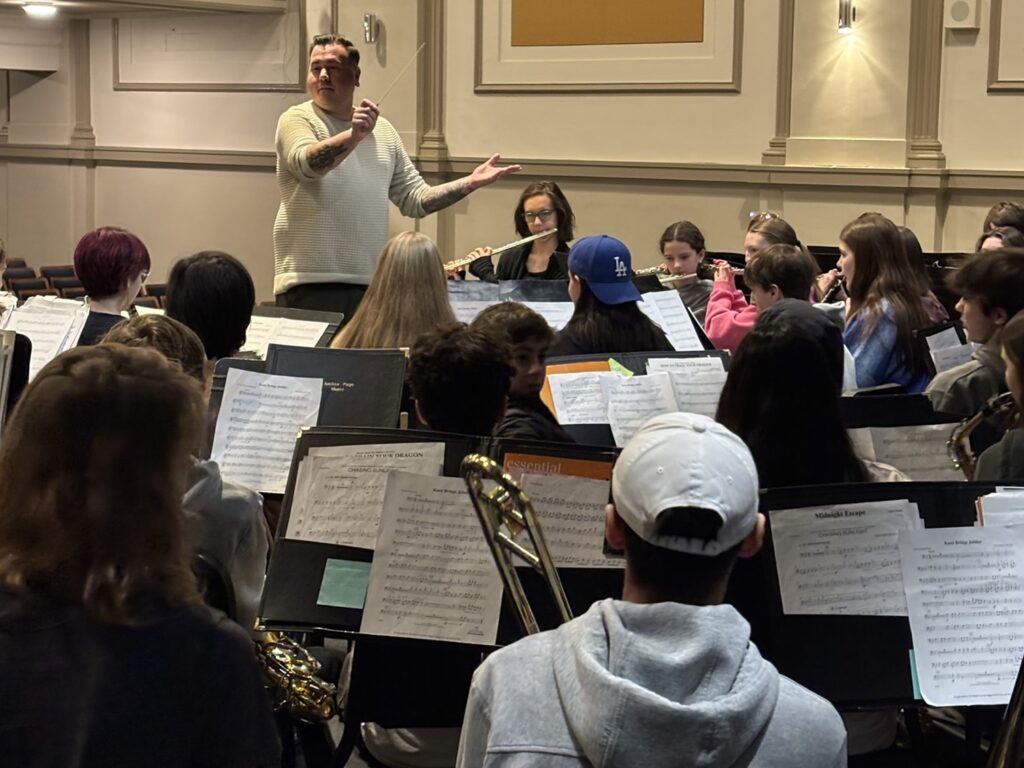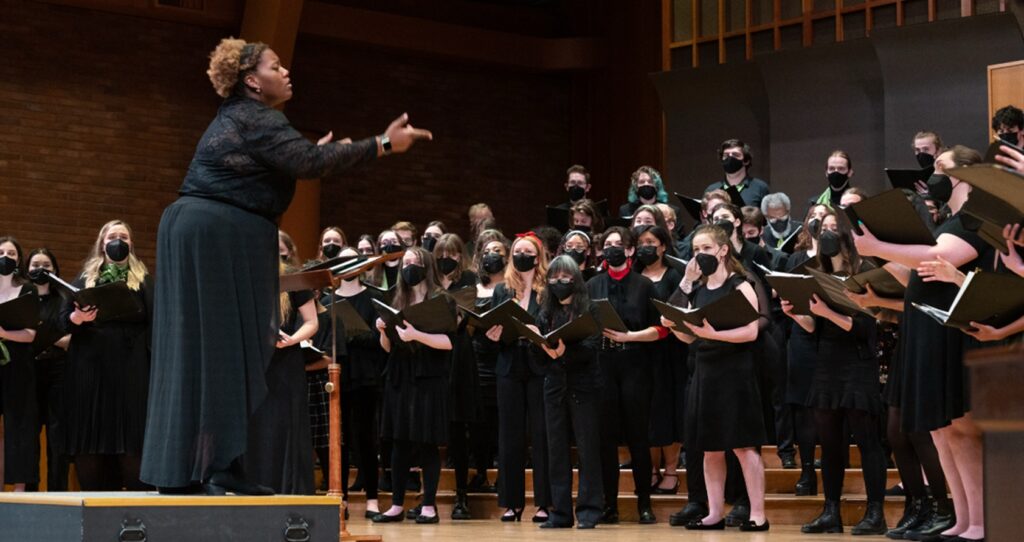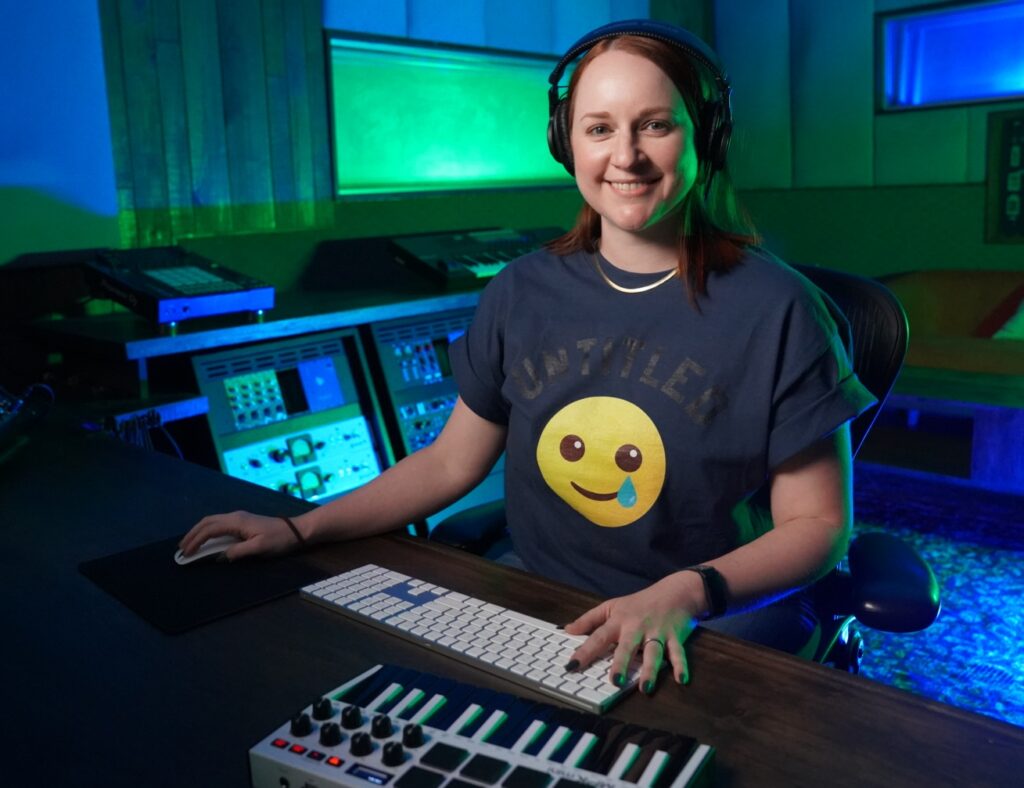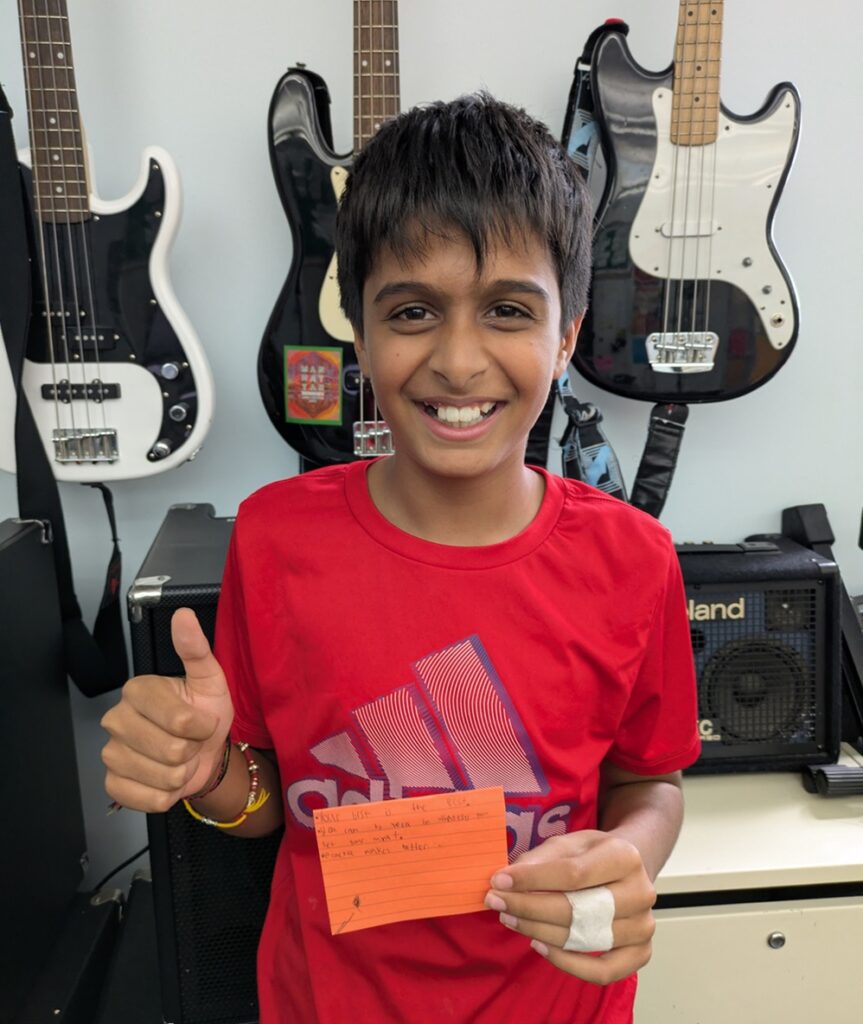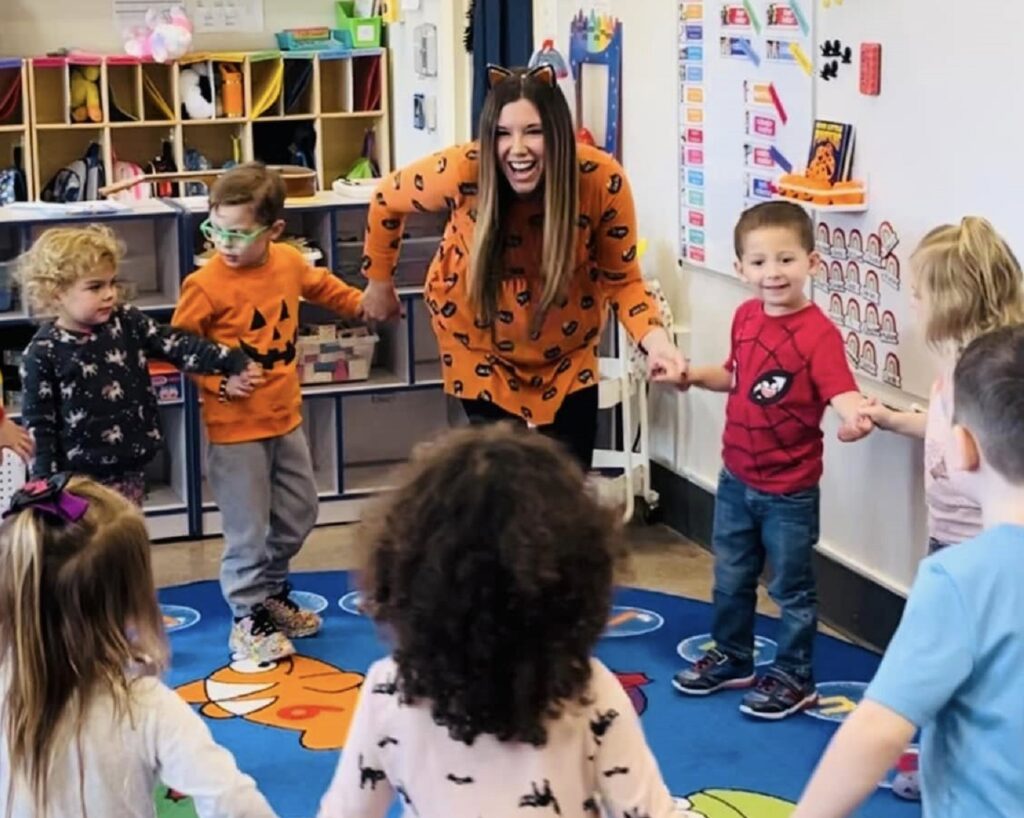Tagged Under:
Go Viral With Purpose: Responsible Social Media Usage
What began as a reluctant step into TikTok quickly became a transformative journey that elevated my school music program, empowered my students and redefined how I advocate for music education.
It all started with TikTok, which was something I feared … something I rolled my eyes at … something I was hesitant to participate in. That all changed in 2022. Spurred on by students in my choir program at Bethel-Tate Middle School, I cautiously entered the social media fray. That decision propelled our program to new heights and created a presence that has benefited our school, students, community and — yes — me.
How it Began
Before diving into TikTok, I was already active on district-run social media accounts like Facebook and Twitter. I used these platforms to share positive updates about our program so that parents and stakeholders could see the impact music was having on students’ lives.
If you aren’t using social media in your role, this is a great starting point. These posts are filtered through whoever manages the district or school accounts and offer an extra layer of protection. I also recommend researching which platforms your community is most active on and tailoring your communication accordingly.
As far as reaching my students, it was made clear to me in 2022 that TikTok was the platform of choice. Our school did not have its own TikTok page, so it was incumbent upon me to advocate for creating one. I worked with my school principal to ensure that I had the school/district’s blessing before I created it.

And so it began with a very simple handle (@MrGlader) and has since organically snowballed into what it is today (nearly 250,000 followers/subscribers across four platforms: YouTube, TikTok, Instagram, Facebook).
I didn’t start with four platforms — just one. Start at whatever pace you’re comfortable with. That might mean posting through a school-managed account or creating your own educator/program-specific page. Once you get going, you’ll be able to figure out what works best for you and expand from there, if or when you’re ready.
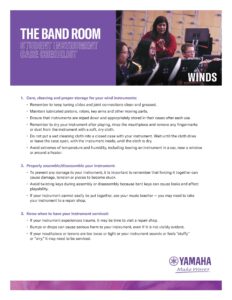
Download this Yamaha Instrument Care-Winds guide.
Trends
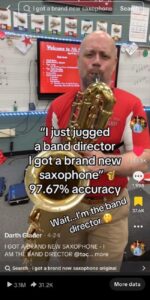
It did not take me long to figure out that “trends” were a way to build our account. Initially, TikTok was recognized for its dance trends, but it has evolved into much more. Now you can find an online community for anything from large-market topics (sports, music, food, etc.) down to niche markets (music educators, lightsaber battle clubs, street food POV, etc.).
Trending sounds. Trending warmups. Trending skits. It’s endless.
As a mid-career teacher, I often rely on students to keep me updated on what’s trending. The accounts I follow don’t always showcase the latest trends on my “For You” feed.
Recently, a 6th-grader made me aware of a funny saxophone meme going around that I had no idea about. I recorded a version of it on my saxophone, and it ended up receiving around 10 million views on my TikTok, Instagram and YouTube accounts combined. I would not have known to do that without the help of my student.
I also try to research what is trending on my own by following other positive accounts that showcase student-friendly trends. Engaging with trends helps build your following, which increases the reach of each post and boosts the potential for future virality. Most importantly, it gives you a broader audience to advocate for your program.
Student Involvement
Involving students in the process of making content has many benefits. Ever wanted to do a goofy warmup and were met with resistance? What if it was their idea? Now, the buy-in is built in! The effort level for the warmup has now risen because they know that this will be seen and heard by others. Students love opportunities for their voices to be heard and to be creative. Giving students some ownership in creating ideas for content gives them that.
Students know what’s trending and what’s not. They can help create content that will reach beyond your own school’s walls. Like I stated earlier, I would not have some videos garner millions of views without their collaboration.
Just last year, my choir students showed me a trend going around that involved solfège singing. It was a filter in which a little ball reacted to pitches of a major scale. If the pitch was in tune, the ball would go through a hole, and then you had to sing the next pitch. My students saw another choir teacher do this with their choir, all using solfège syllables together. We recorded a version of ours and posted it … that video received over 100 million views on YouTube!
The students came up with the idea, had to sing it together, work on solfège and intonation, and had the amazing feeling of being heard by over 100 million people all over the world. Experiences like this automatically have benefits with recruitment, retention, awareness, pride and the ability to advocate for your program.
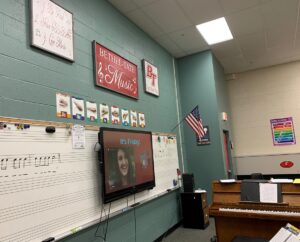
Benefits
Utilizing social media for our music program has benefited the program, the students, the community and me as an educator.
The program has benefited from worldwide recognition. Hundreds of millions of views, millions of “likes” and thousands of followers/subscribers have helped put our small, rural program on the map. Our “BT” logo in our music room is now recognizable to thousands. This visibility has sparked community pride, supported fundraising efforts, and contributed to standing-room-only concert attendance.
Along with the usage of social media, our school participation rate in music as an elective has more than doubled since I began the account. We now boast over 50% of the student body participating in music at the middle school level. Our digital presence helps with recruiting and retention in a way that almost becomes automated. I have elementary students who see me in the hallway and say, “I follow you on YouTube” or “My mom follows you on TikTok.” It’s built-in recruitment that works passively while we continue doing what we already do.
THE YAMAHA EDUCATOR NEWSLETTER: Sign up to receive real-world advice, tips and instrument guides!
10 Best Practice Tips
Still with me? Want to join the social media realm as a music educator? Here are some of my best practice tips to help get you started:
1. Ask for permission first. This is not one of those “ask-for-forgiveness-later” situations. Failure to ask for permission to start your own social media account to either represent the program or you as an educator could land you in hot water. Instead, be transparent with your administration from the beginning. Explain why you want to start this additional platform and the benefits it can bring. If your administrator does not permit you to start your account to represent your program or your position at the school, then do NOT start one. Instead, look for ways to continue to advocate for permission, and, in the meantime, utilize the available assets to your best ability.
2. Outline how you plan to use the account. Does it represent just you or does it represent the program? Does it showcase performances, rehearsal time, skits, teaching tips, etc.? You must be able to articulate the goals of the page.
3. Do not mix a new account with a personal account. If you have your own Instagram, TikTok, YouTube, etc., that’s fine. Continue to do so with your own best practices in mind. I wouldn’t merge your personal account with a new account designed for work activity, though. Have your school social media accounts be just for that: school. There is no need to mix your personal life with a school account.
4. Know your school’s social-media policy. Social media varies from school to school, district to district and state to state. It is incumbent upon you to know the social-media policy, abide by that policy and adapt your platform to work within it.
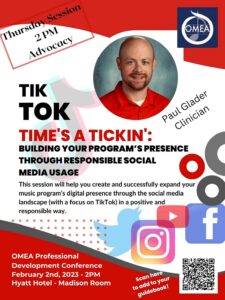
5. Create extra safeguards. Our school district was OK with me working within its social-media usage policy. However, since my usage is so unique to our district, I created a social media waiver just for my classroom and usage on our pages. Our district lawyer looked over the waiver and approved it. This not only adds another layer of protection for me, but it also adds transparency to the families of the students involved. It states that I am not monetizing any usage of students with the usage of these accounts. With our added popularity, I wanted to get ahead of any questions that may arise with that. Transparency and organization will help get ahead of potential questions/conflicts.
6. Set your own rules for the account to live by. Yes, have the school’s policy in mind, but also create additional rules for you to live by with your account. This will help you in decisions of “should I post?” Some examples: Are you recording during school or strictly off-contract hours? Are you including students’ faces? Will you allow comments or turn off comments for the posts? Is this post positive and inspirational or could it hurt someone’s feelings? Set rules that you are comfortable with representing you and the program. Once again, communicate these rules with your administrators.
7. Plan your posts and wait to post. Have ideas in mind before you post? Create “drafts” of your posts and do not post instantly. Treat it as if it’s a response to an inflammatory email. Just like that email, posting right away may cause you to make a mistake in your post. Did you accidentally post a student’s face? Did you not know there was something negative associated with a “trend”? Waiting to post will help you evaluate possible outcomes before you post. Also, consider how often you post. Posting too much in a short period can cause your profile to become buried with low views. Not posting regularly may cause your followers to forget your profile and not engage as much when you do post. I suggest posting once a week and going from there. You can set your parameters.
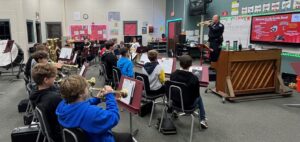
8. Monitor the account after posting. If the platform is under your control (not the school), then it is also your responsibility to monitor the comments on the posts. This doesn’t take much time, but it does take consistent monitoring. If the students are involved in the video, whether it be aural or visual, it is even more important to make sure that comments are positive and appropriate. If students are involved, you also have the option to “turn off comments” on every platform. I do not monitor quite as much if it’s a video that just features me. Once again, talk this through with your administrator to make sure you have this all planned out ahead of time.
9. Monetization. At certain points, monetization becomes a possibility based on your follower/subscriber counts. This is another topic that will vary from school to school, public to private, state to state, etc. Personally, I’m strongly against monetizing off of student involvement, and it goes against my contract. Because of this, I created two separate accounts: One is for student involvement and represents the program, and the other is for videos I make off-contract hours. I do monetize the latter. I approached my administration about this and received the proper permission from the administration and the district lawyer.
10. Have fun! These tips may seem like a lot, but I have found this all to be extremely manageable. My own best practices continue to evolve as I discover more and learn more … evolve with new aspects of social media that continue to come out … evolve with any rules/laws that would dictate change. Be ready and able to adapt as social media continues to adapt.
______________________________________
The benefits of using social media for my program far outweigh any of the extra “work” I have created for myself. Using social media in a thoughtful, intentional way can breathe life into your program, energize your students and strengthen your school community.
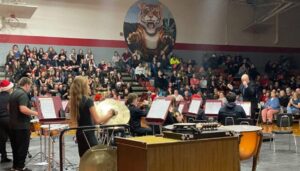
It’s fun. It’s effective. And it’s a powerful tool to shine a light on the great things already happening in your music room. Let others see the joy, learning, and creativity you and your students bring to life every day.
Top Photo by Chainarong06/Shutterstock










